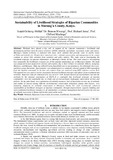| dc.description.abstract | Wetlands have played a key role in support of the riparian community’s livelihoods and development and have been the source of forest, wildlife, minerals, agriculture, recreation, water and energy. Murang’a County in Kenya, is endowed with many such wetlands that provide water to nearby towns of Thika and Nairobi city. Despite these important roles, wetlands conservation and management in the county continue to attract little attention from scientists and policy makers. This study aims at investigating the livelihood strategies of riparian communities in Murang’a County, Kenya. This study aimed at investigating how sustainable the livelihoods strategies are of the riparian communities are in Murang’a County. The study was conducted in four purposively selected sub-counties, due to their richness in wetlands: Kiharu, Kangema, Mathioya, and Maragua. Data was collected using household’s survey questionnaires, key informant interviews, and focus group discussion. Questionnaire were administered to a randomly selected sample of 404 respondents from the riparian community in the four sub-counties. Data was analyzed using SPSS software version 26.0. Chi-squared test was used to test for association between livelihood strategies and effects of encroachment into wetlands. Rejection value for statistical tests was set at P< 0.05. Results showed an encroachment rate into the wetlands by the riparian communities of 60.4%. It is concluded that livelihood strategies of riparian communities were not sustainable due to a high rate of encroachment, inadequate enforcement of laws and policies, On the other hand, over exploitation of wetlands resources, lack of knowledge on wise use of wetlands and conflict of interest among different environmental conservation institutions among other factors, were impacting negatively on wetlands conservation in Murang’a County. The study recommends enhanced sustainability of livelihood strategies of riparian communities through empowerment, capacity building and well-coordinated livelihood strategies by all stakeholders in wetlands management that will lead to the wise use of wetlands ecosystems in Kenya and in other parts of the world. | en_US |

